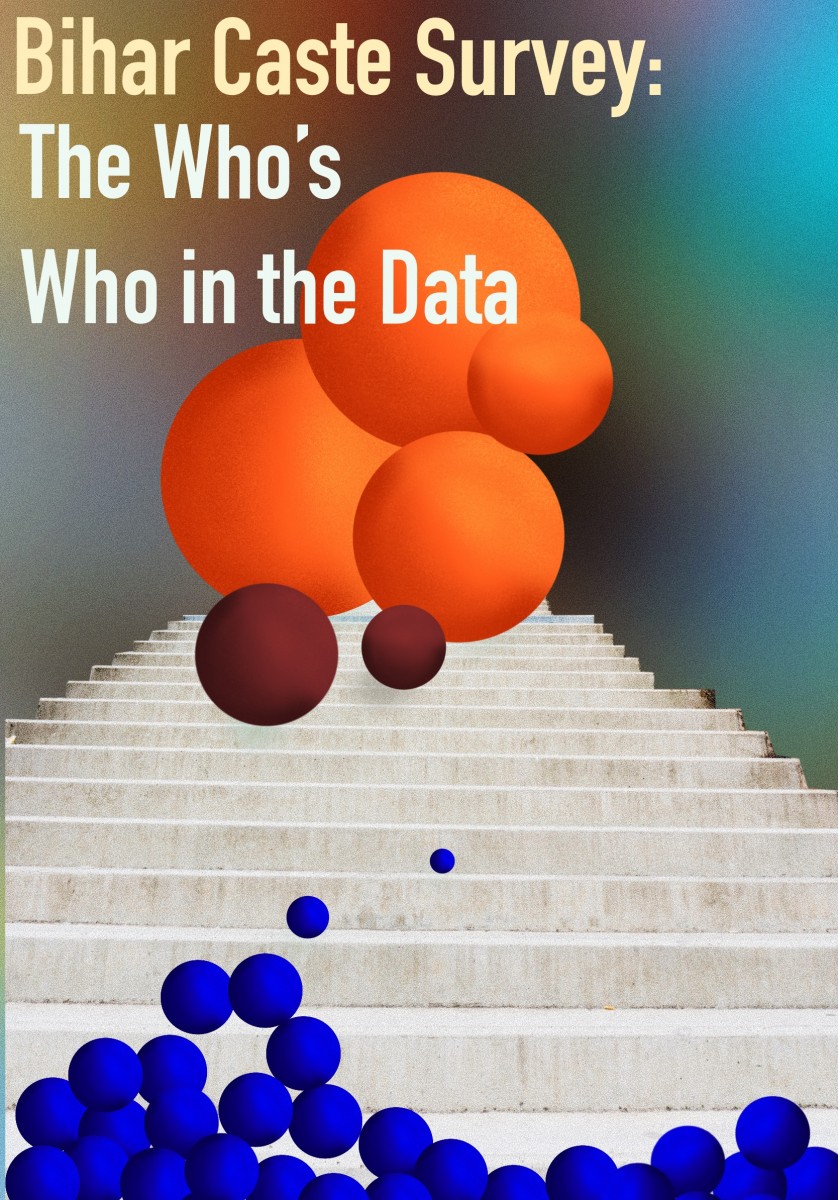Bihar Caste Survey: The Who’s Who in the Data | Sinduria Baniya
Beyond politics, the Bihar caste survey is a revolutionary document.
A public document, the first ever after 1931, allowing for people to stand up and be counted.
We go down to the wire, on what each of the numbers unveiled mean.
Who are the people referred to by percentages in the survey?
Today we look at Sinduria Baniya (176,310 people).
§
Identifying the Sinduria Baniya group is not a difficult task because their name makes their job obvious.
They sell vermillion to women who follow the Hindu religion and are married.

Illustration: Pariplab Chakraborty
There is no historical account as to when the tradition of applying vermilion first started in this country. However, the use of indigo during the Indus valley civilisation, perhaps as a colouring agent, is indicated by excavated remains. The caste group may have originated back then but this cannot be claimed with certainty. The people of this caste prepare vermilion from the seeds obtained from a plant called Camellia, in the same way that indigo is extracted from the seeds obtained from the indigo plant. It is possible that there was, at that time, no trend of applying vermilion among women.
A copper statue of a dancer found from the remains of the Indus Valley civilisation, wearing clothes that look very different from what women wear today, offer some indications. The bracelets in her hands must be either of copper or of shell obtained from the sea. Even today, bracelets made of conch shells are worn by married women in north and east India.
Since there is no specific information recorded about this caste group in history, nothing can be said with certainty. It has been speculated that when Aryans arrived in this country, they must have asked enslaved women to apply vermilion. The Aryans themselves wear a sacred thread, janeu, or keep a choti (a tuft of hair), with which they are identified.
This notion of slavery also gains ground from Ramayana, an Aryan Brahmin epic, which mentions that Hanuman applied red vermillion paste on his body as a proof of his servitude towards his master Ram. However, this text also states that someone told Hanuman that since Sita is Ram's wife and applies vermilion in his name, she is Ram's greatest servant. Upon hearing this, Hanuman replied that Sita applies vermillion only in the parting of her hair while he paints his entire body red. A verse from Hanuman Chalisa also states that the one who turned his body red with vermilion, that is Hanuman, is called 'Lal Langur'.
Sinduria Baniyas grow camellia plants and prepare vermillion by drying the fruits obtained from it. Once dried, women in the Sinduria households help in grinding it finely. The vermillion thus obtained is then sold in the market.
Sinduriya Baniyas are different from most Baniyas because they make the products they sell. They are also distinct from Jogis and Churihars, though all of them belong to a community which furnishes symbols of matrimony to women.
Sinduria Baniyas are also different from other Baniyas in their disavowal of caste division. They have provided vermillion to all women irrespective of caste. On this basis, their work can be called noble. This is why even today when things are getting costlier by the day, vermillion never seems to become expensive. The community have seldom indulged in black marketing or hoarding. They are also called Kathbaniya which literally means a "baniya only in name." In Bihar they were also called Kaithal Vaishya. In Odisha and West Bengal, again, they were called Sinduria Baniya.
In Bihar, the population of this caste group is 176,310. However, there are two problems with this number. First, the people of this caste now want to avoid being referred to as Sinduria Bania because they are unable to form matrimonial alliances with affluent Bania families. As a result, being a Sinduria has become a stigma for them.
Secondly, on April 5, 2013, the Bihar government removed this caste group from the list of prosperous Other Backward Class castes (Schedule-2) and included them in the list of Extremely Backward Castes (Schedule-1). Since then, people from other castes of the Baniya community have also obtained caste certificates identifying themselves as Sinduria Bania.
Today, their traditional profession is also in dire straits as big companies have now entered the market as vermillion manufacturers.
Translated from Hindi by Naushin Rehman. Read the Hindi original here.
Read earlier parts of the series on the following communities by clicking on their names: Ghasi | Santrash | Madaria | Koeri/Kushwaha | Chaupal | Nai/Hajjaam | Pasi | Rangrez | Chamar | Gorkan | Jutt | Yadav | Kamar | Chik | Bari and Bauri | Dhuniya | Donwar.
The series is available in Hindi here and in Urdu, here.
This article went live on November thirtieth, two thousand twenty three, at thirty minutes past two in the afternoon.The Wire is now on WhatsApp. Follow our channel for sharp analysis and opinions on the latest developments.




